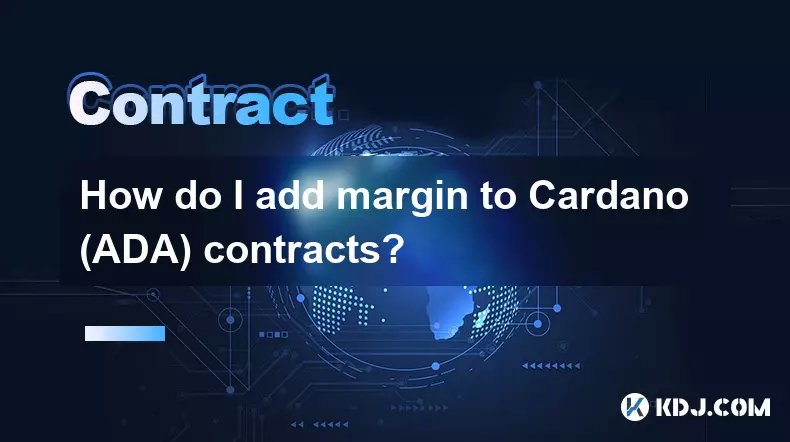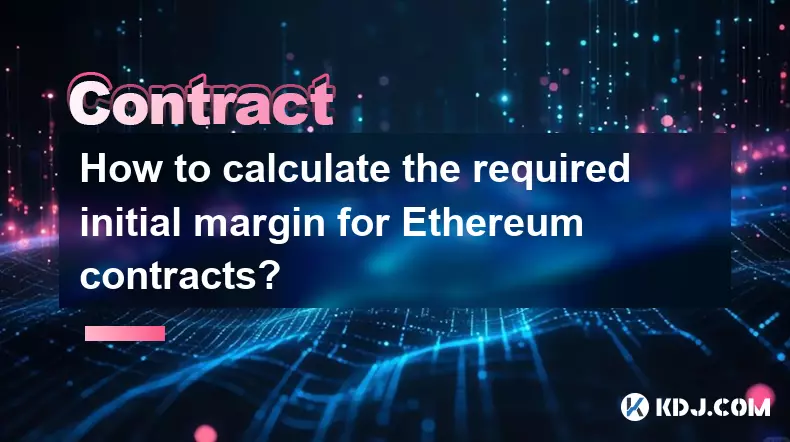-
 bitcoin
bitcoin $120167.907534 USD
1.27% -
 ethereum
ethereum $4468.611945 USD
2.53% -
 xrp
xrp $3.013607 USD
1.80% -
 tether
tether $1.000549 USD
-0.01% -
 bnb
bnb $1092.592149 USD
6.28% -
 solana
solana $231.391244 USD
4.59% -
 usd-coin
usd-coin $0.999699 USD
-0.04% -
 dogecoin
dogecoin $0.259020 USD
4.30% -
 tron
tron $0.342747 USD
0.34% -
 cardano
cardano $0.860977 USD
1.07% -
 hyperliquid
hyperliquid $50.155412 USD
5.34% -
 chainlink
chainlink $22.637678 USD
0.46% -
 ethena-usde
ethena-usde $1.000528 USD
-0.07% -
 avalanche
avalanche $30.613779 USD
-0.07% -
 stellar
stellar $0.403905 USD
0.94%
How do I add margin to Cardano (ADA) contracts?
On Cardano, "margin" is implemented via Plutus smart contracts that lock collateral—like ADA or native tokens—in script-controlled outputs, enabling decentralized lending and borrowing without traditional intermediaries.
Sep 27, 2025 at 07:54 pm

Understanding Margin in Cardano (ADA) Smart Contracts
Cardano operates on a proof-of-stake blockchain that supports smart contracts through its Plutus platform. Unlike traditional financial systems, the concept of 'margin' does not directly apply within native Cardano contracts as it would in centralized exchanges or margin trading platforms. Instead, developers must simulate margin-like functionality using on-chain logic and collateral mechanisms embedded in Plutus scripts.
1. Margin in decentralized environments refers to locking assets as collateral to enable leveraged positions or borrowing. On Cardano, this requires constructing custom Plutus validators that enforce rules around asset deposits, loan issuance, and liquidation thresholds.
- Since Cardano’s ledger model is based on the Extended UTXO (EUTXO) system, each contract state must be explicitly defined within transaction outputs. This means any margin mechanism must encode collateral balances, debt obligations, and time-locked conditions directly into script outputs.
- To implement margin behavior, developers define validator scripts that only allow spending under specific conditions—such as repayment of borrowed value plus fees, or forced liquidation when collateral value drops below a set ratio.
- The process involves creating off-chain components (using Haskell or Plutus Tx) that construct transactions satisfying these validators, ensuring users can deposit ADA or native tokens as collateral and receive synthetic assets or liquidity in return.
- All operations must respect balance invariants and avoid over-leveraging by validating input data against on-chain parameters such as price feeds from oracles and predefined risk thresholds.
Building Collateralized Positions with Plutus
Implementing margin functionality on Cardano relies heavily on writing secure and deterministic Plutus scripts that govern fund access. These scripts act as escrow agents, holding collateral until certain conditions are met.
1. A typical setup begins with a user submitting a transaction that locks ADA into a Plutus script address. This transaction includes datum values specifying the amount deposited, loan terms, and borrower identity.
- Another transaction, triggered later, may redeem part of the locked ADA after verifying that external conditions—like sufficient collateralization—are satisfied.
- Developers use redeemer values to signal intent (e.g., “repay” or “liquidate”) and datums to store state (e.g., “$500 worth of ADA locked”). Both are checked against business logic inside the validator.
- Time constraints can be enforced via validity intervals or required signatures from oracle providers who report market prices.
- Because every action is a blockchain transaction, all margin-related events—deposits, withdrawals, liquidations—are permanently recorded and publicly verifiable.
Integrating Oracles for Dynamic Risk Management
Reliable price data is essential for maintaining healthy margin positions. Without accurate valuations of collateral and debt, automated enforcement of margin calls becomes impossible.
1. Third-party oracle services publish token prices by committing them in on-chain transactions. Smart contracts reference these outputs to assess current market conditions before allowing withdrawals or triggering liquidations.
- Oracle-fed data must be timestamped and signed to prevent manipulation. Scripts validate both the source and freshness of pricing information before proceeding.
- Some protocols aggregate multiple oracle feeds to reduce dependency on a single provider, increasing resilience against downtime or attacks.
- When the ratio between locked ADA value and borrowed amount falls below a threshold—say 150%—the contract allows third parties to initiate liquidation in exchange for a reward.
- Liquidators submit transactions that unlock a portion of the collateral, repay the debt, and claim their incentive—all governed by the same Plutus validator that enforced initial deposit rules.
Frequently Asked Questions
What prevents someone from withdrawing all their ADA immediately after taking a loan?Plutus validators block unauthorized spending. A withdrawal transaction will only succeed if it meets all conditions coded into the script, such as proving full repayment or maintaining minimum collateral levels.
Can I use non-ADA assets as margin on Cardano?Yes. Native tokens issued on Cardano can serve as collateral if the Plutus script is designed to accept them. The validator must explicitly recognize and value the token type during evaluation.
Are there pre-built tools to simplify margin contract development?The Plutus Application Framework (PA-Framework) offers reusable libraries for common DeFi patterns, including staking, lending, and vault systems that support margin-like operations. These accelerate development while promoting best practices.
How are liquidations handled if the network is congested?Transactions remain pending until included in a block. However, since Plutus scripts evaluate time bounds and oracle data at execution, delayed processing does not invalidate liquidation eligibility as long as the underlying conditions still hold upon inclusion.
Disclaimer:info@kdj.com
The information provided is not trading advice. kdj.com does not assume any responsibility for any investments made based on the information provided in this article. Cryptocurrencies are highly volatile and it is highly recommended that you invest with caution after thorough research!
If you believe that the content used on this website infringes your copyright, please contact us immediately (info@kdj.com) and we will delete it promptly.
- BlockDAG, DOGE, HYPE Sponsorship: Crypto Trends Shaping 2025
- 2025-10-01 00:25:13
- Deutsche Börse and Circle: A StableCoin Adoption Powerhouse in Europe
- 2025-10-01 00:25:13
- BlockDAG's Presale Buzz: Is It the Crypto to Watch in October 2025?
- 2025-10-01 00:30:13
- Bitcoin, Crypto, and IQ: When Genius Meets Digital Gold?
- 2025-10-01 00:30:13
- Stablecoins, American Innovation, and Wallet Tokens: The Next Frontier
- 2025-10-01 00:35:12
- NBU, Coins, and Crypto in Ukraine: A New Yorker's Take
- 2025-10-01 00:45:14
Related knowledge

What is the difference between futures and perpetual contracts for Bitcoin?
Oct 02,2025 at 11:54pm
Understanding Bitcoin Futures Contracts1. Bitcoin futures are derivative instruments that allow traders to speculate on the future price of Bitcoin at...

What is the best time to trade PEPE contracts?
Oct 03,2025 at 11:54am
Understanding PEPE Contract Volatility1. PEPE contracts exhibit extreme price fluctuations due to their meme-based nature and low market cap. Trading ...

What are the common mistakes to avoid with Bitcoincoin contracts?
Oct 03,2025 at 08:54am
Emerging Trends in the Cryptocurrency Market1. Decentralized finance (DeFi) platforms continue to expand their influence across the blockchain ecosyst...

What is the maintenance margin for Bitcoin contracts?
Oct 02,2025 at 01:36am
Decentralized Exchanges Gain Momentum in 20241. Decentralized exchanges (DEXs) have seen a significant rise in trading volume, surpassing centralized ...

How to use technical analysis for trading XRP contracts?
Oct 03,2025 at 01:18pm
Understanding Price Patterns in XRP Futures1. Identifying chart patterns such as triangles, head and shoulders, and double tops or bottoms can provide...

How to calculate the required initial margin for Ethereum contracts?
Oct 01,2025 at 06:01am
Understanding Initial Margin in Ethereum Futures1. The initial margin for Ethereum futures contracts represents the minimum amount of capital a trader...

What is the difference between futures and perpetual contracts for Bitcoin?
Oct 02,2025 at 11:54pm
Understanding Bitcoin Futures Contracts1. Bitcoin futures are derivative instruments that allow traders to speculate on the future price of Bitcoin at...

What is the best time to trade PEPE contracts?
Oct 03,2025 at 11:54am
Understanding PEPE Contract Volatility1. PEPE contracts exhibit extreme price fluctuations due to their meme-based nature and low market cap. Trading ...

What are the common mistakes to avoid with Bitcoincoin contracts?
Oct 03,2025 at 08:54am
Emerging Trends in the Cryptocurrency Market1. Decentralized finance (DeFi) platforms continue to expand their influence across the blockchain ecosyst...

What is the maintenance margin for Bitcoin contracts?
Oct 02,2025 at 01:36am
Decentralized Exchanges Gain Momentum in 20241. Decentralized exchanges (DEXs) have seen a significant rise in trading volume, surpassing centralized ...

How to use technical analysis for trading XRP contracts?
Oct 03,2025 at 01:18pm
Understanding Price Patterns in XRP Futures1. Identifying chart patterns such as triangles, head and shoulders, and double tops or bottoms can provide...

How to calculate the required initial margin for Ethereum contracts?
Oct 01,2025 at 06:01am
Understanding Initial Margin in Ethereum Futures1. The initial margin for Ethereum futures contracts represents the minimum amount of capital a trader...
See all articles










































































